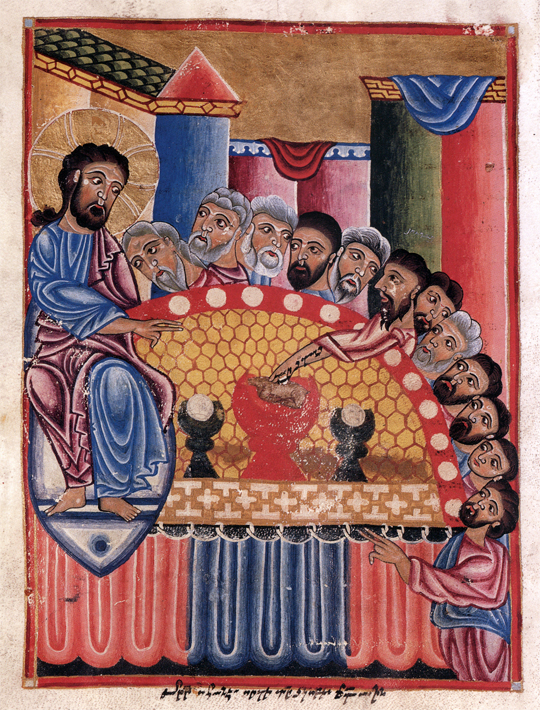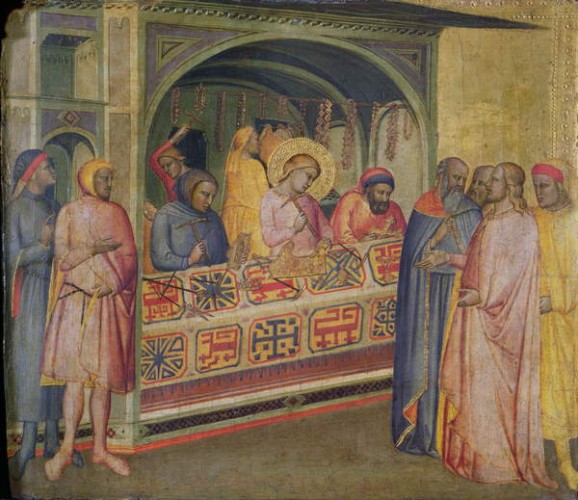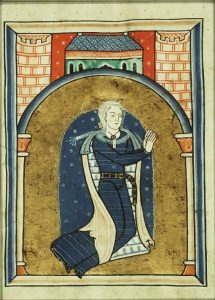

The ways in which scholars research the iconographic traditions of the Middle Ages is continuously evolving. In order to address this, the Index of Medieval Art organized and sponsored a roundtable, Encountering Medieval Iconography in the Twenty-First Century: Scholarship, Social Media, and Digital Methods, at the 54th International Congress on Medieval Studies at Western Michigan University in Kalamazoo. The five panelists briefly presented on the ways in which they incorporated iconography into their teaching, research, and curatorial work. They then participated in a discussion of how they use and develop online resources, such as image databases, to reach students and researchers. The result was a lively dialogue about how digital approaches can make medieval iconographic study more accessible to a diverse, global audience.

One of the first topics of discussion was the avenues by which viewers encounter medieval iconography in the twenty-first century. Anne Stanton, Associate Professor of Art History at the University of Missouri, raised the point that popular social media outlets and online databases are often the first portals through which many students gain access to medieval images and learn about subject matter in works of art. Many institutions have responded to this this fact by using social media platforms to broaden interest in iconography and connect users to works of art. The many vibrant examples of social media use in the field, ranging from museums to libraries, include the Getty, Dumbarton Oaks, and the British Library. Sabine Maffre, Curator of the Mandragore Database at the National Library of France, discussed developments at the library’s blog Gallica, which has been inviting professional bloggers to write posts about illuminations in order to diversify their audience and make their medieval image collections more visible.

Beyond questions of access, another change has occurred in the ways in which we think about iconography. Konstantina Karterouli, postdoctoral fellow and graduate of Harvard University, presented an Artificial Intelligence (AI) project that the Dumbarton Oaks Research Library & Collection is developing with the goal of teaching computers to recognize the different architectural elements of a medieval building. Commenting on the wider potential of this approach, Maffre also noted that the Bibliothèque nationale de France (BnF) staff have been working toward implementing automatic recognition of manuscript illuminations through AI. A contrasting approach to iconography, presented by Isabelle Marchesin of the Institut national d’histoire de l’art (INHA) at the Sorbonne in Paris, faces head-on the problem of offering something that AI still cannot provide: interpretations of specialized content. The OMCI (Ontology of Medieval Christianity in Images) project, founded and developed by Marchesin, is based on the concept that, beyond narrative and portraits, Christian medieval images implicitly refer to another level of signification that is ontological and strongly connected in this case to theology as a holistic system of explanation of the world.

One important takeaway from the roundtable was the recognition that the role of the iconographer itself is changing. As Professor Marina Vicelja of the University of Rijeka emphasized, rather than requiring the solitary work so often undertaken in the past, it could and should be seen in light of collaborations, interdisciplinary research, and international networks. A starting point could be the implementation of cross-discoverable databases, shared standardized vocabularies, and the use of platforms like Biblissima, a digital library and widely interoperable data cluster designed to gather and give access to the main iconographic and textual databases. These ideas inspired discussion of the difficult balance between the strategies used by database specialists and the kinds of usability expected by twenty-first century researchers. Karterouli strongly emphasized the importance of standardization in these endeavors to help retrieve information, and Vicelja stressed the necessity of integrating metadata in order to avoid misunderstandings.
In the twenty-first century, we find ourselves at a crossroads between traditional methods of iconographic study and the implementation of pioneering technologies such as AI. The potential for interoperable platforms to enhance the research experience could answer new expectations with new possibilities. While it can be difficult to strike a balance between time-tested approaches and new ideas, the tension is proof that the study of iconography is very much alive and evolving. We hope that the Index roundtable at Kalamazoo was only the first word in a vibrant and expansive dialogue among an international community of creators and consumers of information about medieval iconography.
Going to Kalamazoo this year? Ever wanted to learn more about the impact of digital tools and methods on medieval art research? Be sure to circle your programs for two exciting sessions on current topics in iconography, a roundtable and a workshop, co-organized by Maria Alessia Rossi and Jessica Savage of the Index of Medieval Art.
I. Saturday, May 11 at 10:30am [Session 346]
Encountering Medieval Iconography in the Twenty-First Century: Scholarship, Social Media, and Digital Methods (A Roundtable)

Stemming from the launch of the new database and enhancements of search technology and social media at the Index of Medieval Art, this roundtable addresses the many ways we encounter and access medieval iconography in the 21st century. Our five participants will speak on topics relevant to their area of specialization and participate in a discussion on how they use online resources, such as image databases, to incorporate the study of medieval iconography into their teaching, research, and public outreach.
Digital Information and Interoperability: Facing New Challenges with Mandragore, the Iconographic Database of the BnF
Sabine Maffre, Bibliothèque nationale de France
Ontology and Iconography: Defining a New Thesaurus of the OMCI at the Institut National d’Histoire de l’Art, Paris
Isabelle Marchesin, Institut National d’Histoire de l’Art (INHA)
Iconography at the Missouri Crossroads: Teaching the Art of the Middle Ages in Middle America
Anne Rudloff Stanton, Univ. of Missouri
Medieval Iconography in the Digital Space: Standardization and Delimitation
Konstantina Karterouli, Dumbarton Oaks
Online Resources in the Changing Paradigm of Medieval Studies
Marina Vicelja, Center for Iconographic Studies, Univ. of Rijeka
II. Sunday, May 12 at 8:30am [Session 505]
Lost in Iconography? Exploring the New Database of the Index of Medieval Art (A Workshop)

This workshop will demonstrate how to get the most out of the new Index of Medieval Art database by using advanced search options, filters, and browse tools to research iconographic subjects. A short presentation will introduce the new subject taxonomy search tool that will further facilitate exploration of the online collection.
We look forward to an invigorating discussion on current issues in iconographic research and to sharing an update on the new database. You can find out more about the 54th International Congress on Medieval Studies at Kalamazoo, held from 9-12 May 2019, including the full schedule here.
54th International Congress on Medieval Studies, Kalamazoo, MI, May 9 to 12, 2019
Sponsored by the Index of Medieval Art, Princeton University

Organizers: M. Alessia Rossi and Jessica Savage (Index of Medieval Art, Princeton University)
Stemming from the launch of the new database and enhancements of search technology and social media at the Index of Medieval Art, this roundtable addresses the many ways we encounter medieval iconography in the twenty-first century. We invite proposals from emerging scholars and a variety of professionals who are teaching with, blogging about, and cataloguing medieval iconography. This discussion will touch on the different ways we consume and create information with our research, shed light on original approaches, and discover common goals.
Participants in this roundtable will give short introductions (5-7 minutes) on issues relevant to their area of specialization and participate in a discussion on how they use online resources, such as image databases, to incorporate the study of medieval iconography into their teaching, research, and public outreach. Possible questions include: What makes an online collection “teaching-friendly” and accessible for student discovery? How does social media, including Twitter, Facebook, and blogging, make medieval image collections more visible? How do these platforms broaden interest in iconography and connect users to works of art? What are the aims and impact of organizations such as, the Index, the Getty, the INHA, the Warburg, and ICONCLASS, who are working with large stores of medieval art and architecture information? How can we envisage a wider network and discussion of professional practice within this specialized area?
Please send a 250-word abstract outlining your contribution to this roundtable and a completed Participant Information Form (available via the Congress Submissions website: https://wmich.edu/medievalcongress/submissions) by September 15 to M. Alessia Rossi (marossi@princeton.edu) and Jessica Savage (jlsavage@princeton.edu). More information about the Congress can be found here: https://wmich.edu/medievalcongress.
The Index is pleased to announce the speakers for two honorary sessions at the International Congress on Medieval Studies to be held at Western Michigan University (Kalamazoo, MI) on May 11-14, 2017.
Organized by Judith Golden and Jessica Savage, Index of Christian Art, Princeton University
Presider: Judith H. Oliver, Colgate University, Professor Emerita

This session will examine the interaction between words and images in medieval manuscripts as they shape the reader-viewer’s experience of the book. How do texts and images interact on the page? How did medieval readers respond to the varied discourses between images and texts? This session endeavors to open up new perspectives in describing, analyzing, and contextualizing manuscript illumination according to their intrinsic or peripheral textual elements. Papers in this session will undertake a close study of a particular manuscript and will expand upon theories for image-text composition by reviewing evidence of an artist’s written instructions; reading images with layered text additions, omissions or annotations; and recovering the reader’s experience through text and iconography.
“Artists and Autonomy: Written Instructions and Preliminary Drawings for the Illuminator in the Huntington Library Legenda aurea (HM 3027)”
“Bodies of Words: Text and Image in an Illustrated Anatomical Codex (Bodleian Library, MS Ashmole 399)”
“A Votive ‘Closing’ in the Claricia Psalter (Walters MS W.26)”
Presider: M. Alison Stones, University of Pittsburgh, Professor Emerita

This session will examine the varied “visual signatures” of manuscript patrons, including dress, gestures, posture, and attributes of donor figures; heraldry and personalized inscriptions; marginal notes, colophons, dedications, and other signs of ownership and use in medieval manuscripts. Building on scholarship presented in the 2013 Index of Christian Art conference Patronage: Power and Agency in Medieval Art, this session will investigate the dynamic system of patronage centered on the interaction of owners with their books (whether as creator, patron, commissioner, or reader-viewer). Papers will address the importance of gender and social roles in book production, use, and readership, or will expand upon the role of patron as instigator in the book creation process, from payment to design.
“How Owner Portraits Work”
“The Patroness Portrait of the Fécamp Psalter (c. 1180): An Unknown Example of Royal Artistic Commission in Angevin Normandy”
“Patron Portrait as Creation Myth: On ‘Production Scenes’ in Illuminated Manuscripts”
In July 2016, Adelaide Bennett Hagens retired from the Index of Christian Art at Princeton University after fifty years of dedicated research and scholarship. She studied under Robert Branner at Columbia University and joined the Index during the directorship of Rosalie Green. Adelaide has studied medieval art in a variety of media, but her passion at the Index and in her personal research has always been manuscript illumination, particularly of the Gothic period. Her publications include “Some Perspectives on the Origins of Books of Hours in France in the Thirteenth Century,” in Books of Hours Reconsidered, edited by Sandra Hindman and James H. Marrow (2013); “Making Literate Lay Women Visible: Text and Image in French and Flemish Books of Hours, 1220–1320,” in Thresholds of Medieval Visual Culture: Liminal Spaces, edited by Elina Gertsman and Jill Stevenson (2012); and “The Windmill Psalter: The Historiated Letter E of Psalm One,” Journal of the Warburg and Courtauld Institutes 43 (1980). In two sessions, we celebrate Adelaide’s accomplishments and recognize her contributions to the Index of Christian Art and to the wider medieval and academic community.
The Index of Christian Art is sponsoring two sessions in honor of Adelaide Bennett Hagens at the 52nd International Congress on Medieval Studies, University of Western Michigan, Kalamazoo, MI, May 11-14, 2017.

Image & Meaning in Medieval Manuscripts: Sessions in Honor of Adelaide Bennett Hagens
Session I: Text-Image Dynamics in Medieval Manuscripts
Session II: Signs of Patronage in Medieval Manuscripts
Organizers: Judith Golden and Jessica Savage, Index of Christian Art, Princeton University
Please see the full call for papers on our website here: https://ima.princeton.edu/conferences/
The Index will be represented at two events at the Medieval Congress at Kalamazoo this year. First is a joint reception with the Research Group on Manuscript Evidence at 5:15 pm on Friday, May 13, in Bernhard 208. Second will be two sessions, titled “Pardon Our Dust: Reassessing Iconography at the Index of Christian Art,” organized and chaired by Index researchers Catherine Fernandez and Henry Schilb, on Sunday from 8:30 to noon in 1145 Schneider Hall. We hope to see many friends there!